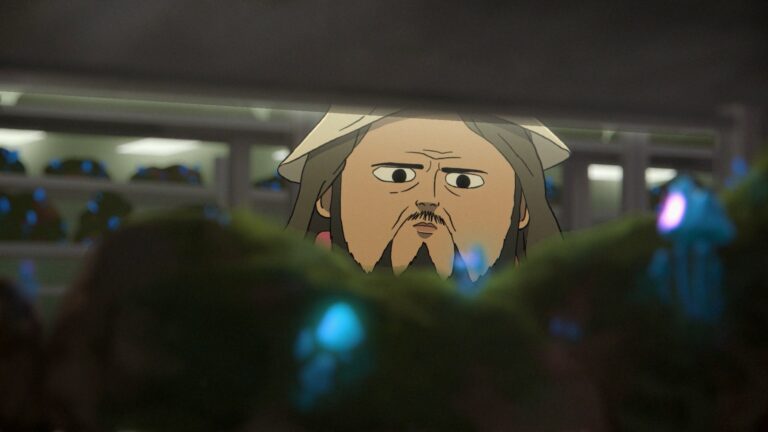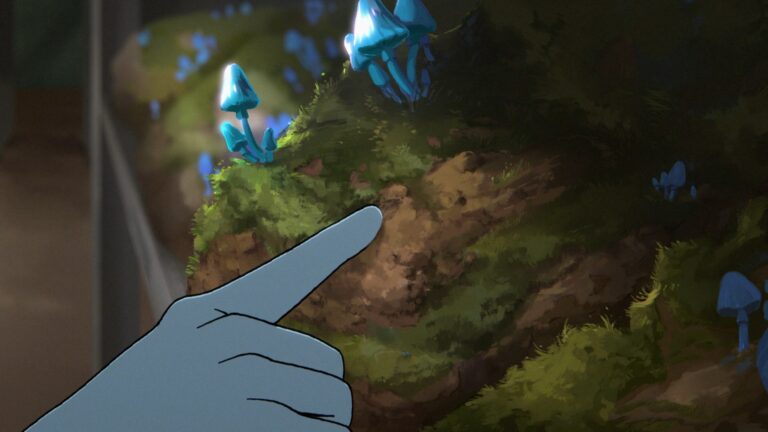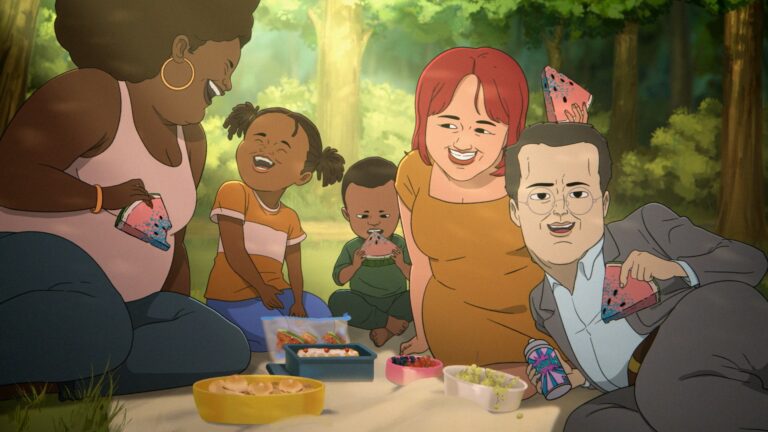Ever wondered what mayhem bubbles behind the glossy curtain of Common Side Effects? Let’s peep inside the writers’ room, where showrunners Joseph Bennett and Steve Hely transform wacky pharma conspiracies into razor-sharp satire and high-voltage thrills. Buckle in — this one’s equal parts science, snark, and slightly unhinged genius.
It All Starts with a Mushroom and a Mission
First off, you can trace the wild alchemy of Common Side Effects to a couple of unlikely sources: Paul Stamets, the real-life mycologist, and the cosmos-minded ethnobotanist Terence McKenna. Seriously. Bennett and Hely, inspired by these pioneers, didn’t just want a funny show about Big Pharma — they craved something weirder, bolder, and punchier. And who could blame them? Animation needed a shake-up.
When Mike Judge and Greg Daniels — the brain trust behind Bandera Entertainment — teamed up with Bennett and Hely in 2019, the mandate was clear: break molds or bust. The idea? Toss two underdog scientists into a world where psychedelic mushrooms might just change everything. Drama, meet delirium.
From Sketches to Storylines: A Brainstorm Like No Other
You’d expect a pharmaceutical satire to start with whiteboards, flowcharts, and a touch of science. Not so fast! Bennett and Hely’s creative process kicks off with a wild stew of brainstorming sessions. According to their interviews, they welcome “the weird way life works,” meaning real-life oddities and chance discoveries get center stage. Someone drops a bizarre pharma anecdote or recalls a news snippet, and suddenly, there’s a storyline.
Here’s how they keep their brainstorming spicy:
- Encourage wild ideas — nothing’s too strange at first.
- Mash up real-world science with surreal, psychedelic twists.
- Draw from diverse pop culture and even medical research gone wrong.
As Steve Hely told ComingSoon.net, they’re not chasing punchlines for their own sake. Instead, they let the characters’ quirks and unique foibles spark much of the comedy.
Writers’ Room Vibes: Chaos, Camaraderie, and Clashing Opinions
Inside the writers’ lair, it’s anything but clinical. Imagine a hub where voices bounce off walls, ideas clash, and the weirder suggestions often win. Bennett and Hely thrive on diverse viewpoints, so their staff includes writers from all sorts of creative and scientific backgrounds. This blend throws open the gates to uncharted narrative possibilities.
What’s fascinating is their openness to improvisation — not just among writers, but with cast members too. Voice actors riff, joke, and sometimes totally veer off-script, which Bennett admits often leads to gold. That spontaneity? You hear it in every rapid-fire exchange between Marshall and Frances.
And teamwork isn’t just a buzzword. As Bennett noted in a ScreenRant interview, mixing up story editors, comedy writers, and even actual scientists keeps the show electric — and a tad unpredictable.
Making the Impossible Look Good: Trippy Animation and Bold Detail
Let’s talk visuals. Common Side Effects didn’t settle for standard-issue animation. Not a chance! Bennett, thanks to his roots at Green Street Pictures, mobilized an international battalion of artists. Their goal? Build a universe that’s both grounded and completely bonkers.
Transitional scenes often spiral into jaw-dropping surrealism. Take any sequence with the mysterious Blue Angel mushroom. Suddenly, frames throb, colors bleed, and reality unravels — drawing viewers deeper into Marshall and Frances’s world. This isn’t just window dressing. Animation choices cue us into the characters’ mental states while dialing suspense to eleven.
And the teams love to experiment, merging wild visuals with fluid character movement. Sometimes, a single scene hops from drab lab to psychedelic fever dream in seconds. Blink and you’ll miss a dozen tiny sight gags tucked in the background.
Jokes Meet Jitters: Nailing Tone Without a Net
A tricky challenge lurked from day one: how do you juggle panic, paranoia, and plot twists without losing laughs? The team’s answer: let the absurdity of the pharmaceutical industry do half the work. Bennett and Hely purposely avoid “sitcom logic.” Instead, they anchor each episode in relatable stakes — like losing your job for doing too much good.
Here’s the magic formula they use:
- Comedy springs from characters’ insecurities, not one-liners.
- Suspense ramps up through genuine threats, not cartoonish villains.
- Real pharma scandals sneak in, just askew enough to feel extra chilling.
In a Paste interview, Hely underscored the show’s aim to “critique the system without losing humanity.” Spoiler alert: Common Side Effects roasts corporate greed, but it always remembers why Marshall and Frances risk everything — a genuine desire to help people.
Spinning Satire Out of Real Science (and Wild Conspiracies)
The real world gives this show limitless ammo. Medication recalls. Drug lab mishaps. Mysterious research data “vanishing.” It’s all fair game. Bennett and Hely pore through headlines and medical journals, mining for material. Sometimes, they exaggerate just a hair; sometimes, the truth proves stranger.
While some storylines might seem plucked straight from the fever dream files, much of Common Side Effects lands disturbingly close to reality. Even the idea of a mind-altering mushroom with healing superpowers? Not far off when you consider the recent medical buzz around psychedelics.
You’ll spot references and satirical jabs at:
- Overpriced healthcare
- Shady clinical trials
- FDA red tape
- Profit-fixated execs
But the satire never gets mean for the sake of it; episodes punch up, targeting callous systems, not people.
Collaboration — With a Dash of Chaos
So, what keeps the show so fresh? The answer: relentless collaboration and a dash of chaos. Every spark, from plotting cliffhangers to layering visual jokes, springs from open debate. Sometimes, days unravel in philosophical arguments over a single line of dialogue. Other times, someone cracks a joke so outrageous, it blossoms into a whole B-plot.
Also, for the perfectionists out there, don’t worry. Bennett and Hely keep the story tight without snuffing out that needed wackiness. Once the scripts settle, artists and voice cast bring it to life, often adding their personal brand of mischief.
Fandom Fever and What’s Brewing Next
Fan response since the pilot dropped has been totally bonkers. Viewers debate Easter eggs, crowdsource pharma conspiracy theories, and even dissect which real-life companies inspired the show’s “Darmiceutix.” Social media buzzed hard after the Blue Angel fungus episode — fans spun out psychedelic fan art and wild predictions.
And yes, good news travels fast. After Adult Swim renewed Common Side Effects in spring 2025, speculation ignited about what’s next. Bennett and Hely promise higher stakes, bigger risks, and even wilder plot twists in the upcoming season. Don’t worry, the mushrooms — and the corporate conspiracies — aren’t going anywhere.
Parting Nuggets from the Laboratory of Mayhem
In a television landscape drowning in safe bets, Common Side Effects rips open the boxes and lets the weirdness pour out. Bennett and Hely run their writers’ room like a high-stakes science experiment: everyone gets a beaker, everyone stirs the pot, and no one shrinks from a little creative combustion. Whether you tune in for the pharma satire, the trip-out visuals, or just to yell at your TV when Marshall gets into trouble (again), you’re along for the wildest ride Adult Swim has cooked up in ages.
So, next time someone tells you animation can’t tackle big ideas, just send them a link — or better, host a viewing party and let the side effects do the talking. Now, who wants a mushroom smoothie?




